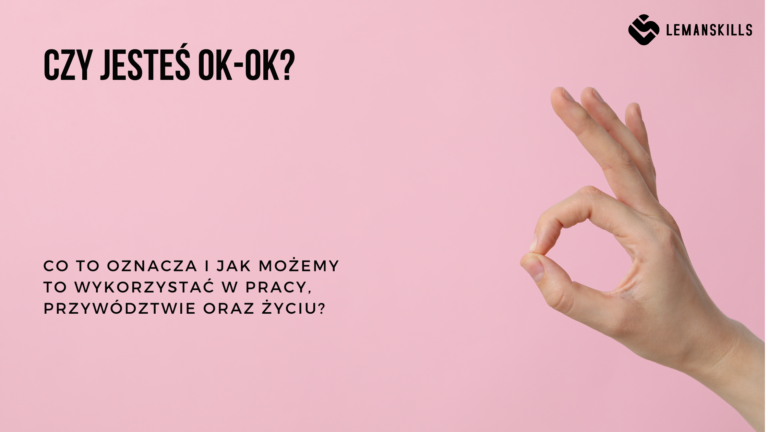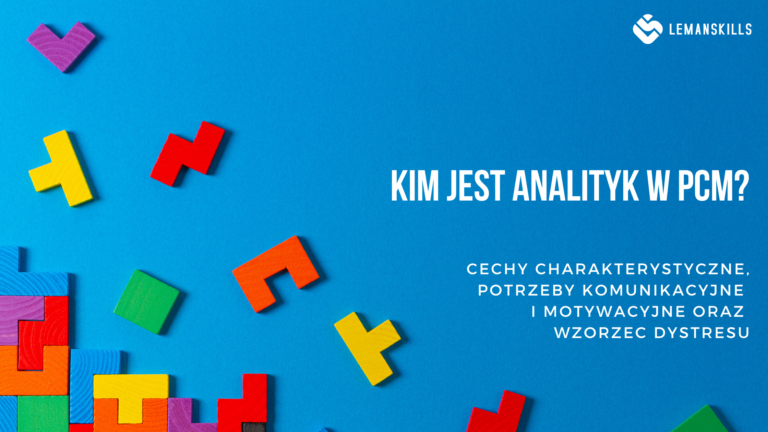
Co to znaczy być OK-OK?
Kiedy myślę o wszystkich warsztatach i procesach mentoringowych, które prowadzę każdego tygodnia, bardzo rzadko nie rozmawiam o tym temacie z ludźmi. Wcześniej czy później jest to część rozmowy – niezależnie czy pracujemy razem nad komunikacją, feedbackiem, leadershipem , zmianą lub transformacją. Dzisiaj historia o Matrycy OK-OK, którego inna nazwa to Matryca Pozycji Życiowych. Jeden z najważniejszych elementów analizy transakcyjnej, podstawa budowania doskonałych relacji: zawodowych i prywatnych. Czym jest Matryca? Matryca to narzędzie, które pokazuje nam cztery opcje składające się z zestawu przekonań, myśli i uczuć, jakie mamy o sobie i innych. W zależności od tego, gdzie jesteśmy, mamy pewną orientację, która staje się podstawą naszych zachowań, sposobów reagowania na to, co się z nami dzieje: zawodowo i prywatnie. Nie ma znaczenia, o której części naszego życia lub pracy myślimy, to narzędzie jest równie dobrze aplikowalne do każdego z nich. Jak wygląda Matryca, możesz zobaczyć na poniższym prostym obrazku: Pierwsza oś opisuje to, co myślimy i w co wierzymy, że jest prawdą, jeśli chodzi o nas samych: kim jesteśmy (jako ludzie ogólnie, ale także w każdej roli, jaką pełnimy w życiu: zawodowej i osobistej), co robimy, jaką wartość mamy z tego powodu itp. Druga oś opisuje te same elementy, ale w kontekście świata zewnętrznego: może to być inna osoba, grupa osób (cała rodzina, zespół itp.) lub cała instytucja (organizacja, państwo, cała partia polityczna itp.). To, gdzie jesteśmy w Matrycy, wpływa na nasz nastrój, nastawienie, zachowania w różnych sytuacjach, sposób, w jaki reagujemy, jak się komunikujemy i podejmujemy decyzje. Pierwszą rzeczą jest uświadomienie sobie, jaką dominującą tendencję wchodzenia w określone kwadranty mamy jako ludzie, ale też w różnych rolach. Kwadrant 1: OK-OK Kwadrant OK – OK to ten, do którego powinniśmy dążyć tak często, jak to możliwe. To przestrzeń, w której czujemy się dobrze i inni również są w porządku. Mam dobre intencje i ludzie również mają dobre intencje. Oczywiście, nie wszystko i nie wszyscy są doskonali, ale staramy się być najlepszą wersją samych siebie, wspieramy się nawzajem, dzielimy się wiedzą i pracujemy jako zespół. To miejsce, w którym mamy i rozwijamy wzrastający światopogląd i sposób myślenia (oryginalnie: Growth Mindset). Dzięki temu zestawowi myśli, przekonań i decyzji, które podejmujemy na jego podstawie odnosimy sukcesy, jesteśmy szczęśliwi i budujemy dobre życie. Widzimy możliwości, obfitość, zamiast luk i rzeczy, których nie mamy lub nie wiemy. Sięgamy po więcej, zamiast się poddawać. Kwadrant 2: OK-Nie-OK Kwadrant OK – Nie-OK pojawia się, kiedy myślisz, że wszystko jest w porządku z tobą, ale z innymi – niekoniecznie. Przykład: „Zawsze robię wszystko, co mogę, żeby skończyć listę zadań przed końcem dnia, a on nigdy tego nie robi. Zawsze pracuje od 9:00 do 17:00, a potem – bez względu na to, ile rzeczy jest niedokończonych – po prostu zamyka komputer i idzie do domu. Nienawidzę tego!”. Albo: „Robię wszystko, co mogę, a ta organizacja? Wymaga tylko więcej i daje coraz mniej!” To miejsce nie jest dla nas zdrowe, ponieważ pod koniec dnia będziemy żywić urazę do wszystkich i wszystkiego. Nawet jeśli na początku będzie to tylko jedna osoba, z czasem stanie się to coraz głębsze, będzie rozwijać się na inne obszary pracy i życia. Kiedy my jesteśmy w porządku, a świat nie, z czym kończymy? Z nienawiścią, urazą, nędznym życiem. Powiedziałabym, że to nie jest najlepsze miejsce do długiego przebywania, szczególnie w perspektywie myślenia o przyszłości. Kwadrant 3: Nie-OK-OK Kwadrant Nie-OK – OK to miejsce o niskim poczuciu własnej wartości. Jesteśmy tam, kiedy myślimy, że wszyscy są w porządku, odnoszą sukcesy, są szczęśliwi, oprócz nas. Dobrym przykładem może być: „Każdy ma kogoś, a ja umrę sama z moimi kotami” lub: „Każdy potrafi poradzić sobie ze swoją listą zadań, a ja wiecznie się nie wyrabiam!” Kiedy myślimy o sobie z tej pozycji, nigdy nie jesteśmy wystarczająco dobrzy. Czasami wybieramy jedną rolę zawodową lub życiową (świadomie lub nie), w której jesteśmy tak źli, że to żałosne, czasami przenosi się to na wszystkie role, które pełnimy. Zależy to od tego, jaki poziom zaniżonej samooceny albo zakazów zabraliśmy ze sobą z dzieciństwa do dorosłego życia. Ludzie, którzy nas wychowują, mają często dobre intencje, ale sformułowania i zachowania, których używają, nie są tak dobre ani adekwatne do tych intencji. W dorosłym życiu na to, co zadziało się w przeszłości nie mamy wpływu, ale na to, co dalej będziemy robić – już bardzo silny (przy okazji polecam fantastyczną książkę w tym temacie). Kwadrant 4: Nie-OK-Nie-OK Kwadrant Nie-OK – Nie-OK pojawia się, kiedy uważasz, że jesteś do bani, ale inni ludzie też. Możesz mieć też przekonanie, że środowisko / organizacja / gospodarka / świat są złe. Przykład: „Mój boże, jestem w tym temacie taki tragiczny, ale nie mogę się uczyć, bo nie mam czasu na nic w tej firmie. Mój kierownik ciągle daje mi więcej do zrobienia, koledzy w ogóle nie są pomocni i muszę robić wszystko sam, nawet jeśli nie mam pojęcia, co robię”. To jest ostateczne, negatywne miejsce, w którym działamy z ustalonego nastawienia (oryginalnie: Fixed Mindset). Nie widzimy żadnych możliwości, mamy zasadniczo fatalistyczny pogląd na świat, siebie, relacje, kompetencje, organizację, z którą współpracujemy itd. Wszystko i wszyscy są źli, nie ma nadziei na lepsze jutro. Najważniejsza rzecz z tego artykułu Sednem sprawy jest to, że wypadamy z pierwszego kwadrantu wielokrotnie każdego dnia. Nie da się tam cały czas pozostać, ponieważ jesteśmy triggerowani przez różne czynniki stresujące, mamy sfrustrowane potrzeby motywacyjne i dlatego popadamy w dystres. Bycie w innym kwadrancie niż najbardziej optymalny oznacza bycie warunkowo OK: ja (lub świat) jest OK tylko wtedy, kiedy… spełniam pewien warunek. Kluczowe jest rozpoznanie, kiedy (w jakich okolicznościach) tracimy naszą optymalną pozycję i co możemy zrobić, żeby jak najszybciej do niej wrócić. Ważne jest również to, jak zachowujemy się w relacjach z innymi: naszymi pracownikami, członkami zespołu, przełożonymi, interesariuszami, współpracownikami, ale także w życiu prywatnym: jako partnerzy, rodzice, przyjaciele, dzieci naszych rodziców. Gdy będziemy tego świadomi i uważni, będziemy mogli kontrolować to, co robimy, i zamiast niszczyć nasze relacje, będziemy mogli je budować jako silne i satysfakcjonujące (dla obu stron). Niezależnie od roli w

